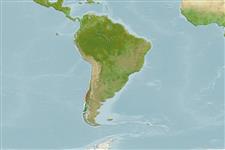Elasmobranchii (sharks and rays) >
Rajiformes (Skates and rays) >
Arhynchobatidae (Softnose skates)
Etymology: Bathyraja: Greek, bathys = deep + Latin, raja, -ae = a ray (Raja sp) (Ref. 45335).
Environment: milieu / climate zone / depth range / distribution range
Ecology
Marine; demersal; depth range 400 - 735 m (Ref. 127873). Subtropical
Southeast Pacific: northern Peru to central Chile.
Size / Weight / Age
Maturity: Lm ? range ? - ? cm
Max length : 80.0 cm TL (female)
Short description
Identification keys | Morphology | Morphometrics
This species is distinguished by having the anterior disc margin distinctly undulating; pectoral-fin apices narrowly or abruptly rounded; preorbital length times orbital length 2.00-2.68; preorbital length times interorbital length 1.02-1.30; interorbital space times orbit length 1.20–-1.50; orbital length times spiracle length 2.00-2.53; with a median row of thorns originating from the posterior half of the disc; number of median thorns 26-30; interdorsal thorns 1 or 2; the dorsal disc surface and tail with finely textured denticles on adults confined to a narrow median band originating just posterior to mid-disc and extending along the tail; teeth arranged in quincunx; predorsal tail vertebrae 62; total predorsal vertebrae 93; pectoral-fin radial count 72. Colouration: uniformly colored on their dorsal and ventral surfaces, no blotches, spots, or other distinctive patterns which is consistent at all sizes from young to adult (Ref. 127873).
Oviparous (Ref. 50449). Eggs have horn-like projections on the shell (Ref. 205).
Life cycle and mating behavior
Maturities | Reproduction | Spawnings | Egg(s) | Fecundities | Larvae
Oviparous, paired eggs are laid. Embryos feed solely on yolk (Ref. 50449). Eggs have horn-like projections on the shell (Ref. 205).
McEachran, J.D. and K.A. Dunn, 1998. Phylogenetic analysis of skates, a morphologically conservative clade of elasmobranchs (Chondrichthyes: Rajidae). Copeia 1998(2):271-290. (Ref. 27314)
IUCN Red List Status (Ref. 130435)
Threat to humans
Harmless
Human uses
Tools
Special reports
Download XML
Internet sources
Estimates based on models
Preferred temperature (Ref.
123201): 7.3 - 10.6, mean 9.4 °C (based on 6 cells).
Phylogenetic diversity index (Ref.
82804): PD
50 = 0.5000 [Uniqueness, from 0.5 = low to 2.0 = high].
Bayesian length-weight: a=0.00513 (0.00253 - 0.01042), b=3.12 (2.95 - 3.29), in cm total length, based on LWR estimates for this Genus-body shape (Ref.
93245).
Trophic level (Ref.
69278): 3.9 ±0.7 se; based on size and trophs of closest relatives
Resilience (Ref.
120179): Low, minimum population doubling time 4.5 - 14 years (Fec assumed to be <100).
Fishing Vulnerability (Ref.
59153): Moderate to high vulnerability (52 of 100).
